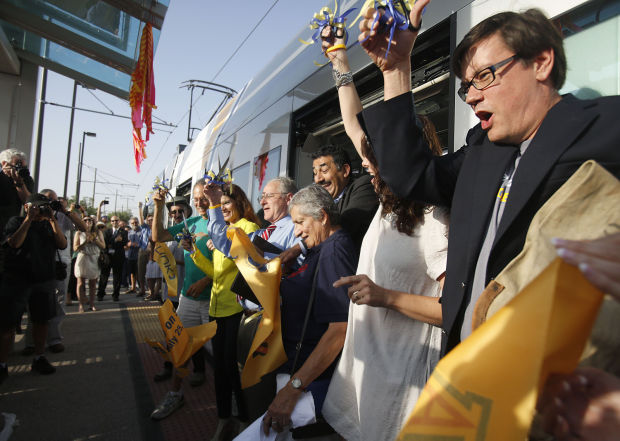“It is a great day for a streetcar ride.”
That was Mayor Jonathan Rothschild’s summation as he launched the $197 million streetcar project into service.
Flanked by a police escort, the streetcar whistle-stopped its way through downtown Friday morning carrying dignitaries to five ribbon-cutting ceremonies.
The grand procession began on the west side of downtown near the Mercado San Agustin.
Councilwoman Regina Romero said the streetcar opening created the start of a new epoch in Tucson history.
“Today marks a very delineated date on how the future of our city is going to continue to prosper and grow,” Romero said.
While naysayers did their best to derail the project, the struggle was worth the effort, Romero said.
“People sometimes add a negative connotation to a fight. And some of the best things in the world have happened because people have had to fight for them: civil rights, women’s rights, human rights,” Romero told a crowd of about 100 people.
“The fight I had to do to make sure the Luis Gutierrez Bridge had money and that it was going to be constructed. To bring the streetcar here to begin with was a good fight,” she said.
The tour then proceeded to stops at the University of Arizona, where it was greeted by the pep band and cheerleaders, Main Gate Square and Fourth Avenue before silently gliding to its final destination at Fifth Avenue and Congress Street, where hundreds of Tucsonans waited to partake in the streetcar’s inauguration.
Dozens of local, state and federal officials basked in the moment, and congratulated one another on a job well done before cutting the final ribbon.
Although no official count was available, city officials said nearly 3,000 people had RSVP’d .
Speakers extolled the economic boom they say was spurred by the streetcar and reminisced on the ups and downs of the decades-long journey it took to see it come to fruition.
City Manager Richard Miranda quipped he didn’t even know what a streetcar was when former Mayor Bob Walkup put him in charge of the $197 million project in 2010. But after four years of hard work, the streetcar is now a reality.
“We visualized a great day in Tucson,” said Miranda said, retiring next Thursday. “I’m very proud as a Tucsonan to be at the helm of this project and see it to a ribbon-cutting day.”
State Sen. Steve Farley, who played an integral part in getting the streetcar on the 2006 ballot, said the project’s opening was a testament to what Tucson can accomplish if people work with, instead of against, one another.
“Look around. We’ve done it. You’ve done it,” Farley said with his voice rising to a crescendo. “This is what Tucson can do when we all work together.”
Rothschild said the streetcar kickoff was only the beginning and he expects even more development to sprout in downtown over the next few years.
Some aren’t ON BOARD
Tucson Bus Rider Union members, however, held signs beseeching city officials to not skimp on bus service to pay for the streetcar.
“We just want to make sure that the bus money stays with buses and they do the trolley on their own budget,” said Bus Rider Union member Jim Thomas. “Ninety-nine percent of public transportation in this town is done on buses.”
Councilman Steve Kozachik said he skipped the celebrations and let Fourth Avenue merchants speak in his place.
“Everybody’s happy to see the system go into revenue service and finally get the construction out of the faces of the merchants,” Kozachik said.
“They can do the celebrating. I’m going to focus on how we pay for the operation and maintenance and the process we’re going to go through to recover the liquidated damages that Oregon Ironworks owes the citizens of this city for all the delays we’ve experienced in getting to this point.”
Tucson can collect up to $2.9 million in late fees. The city is still negotiating a final deal.
Others think downtown has gotten too fancy.
“There are too many restaurants geared to a certain type of status,” said downtown resident Jorge Ruiz, 47.
Ruiz said while he’s glad the streetcar’s here, he’s concerned lower-income folks don’t have a place in downtown’s renaissance.
WHO picked up this tab?
A heavy police presence was maintained throughout the celebration. But most of the officers were off-duty and getting paid from a portion of a $306,000 federal transit security grant.
As for the other costs, most of those were covered by donations from Friends of the Tucson Streetcar and other groups, city officials said.





